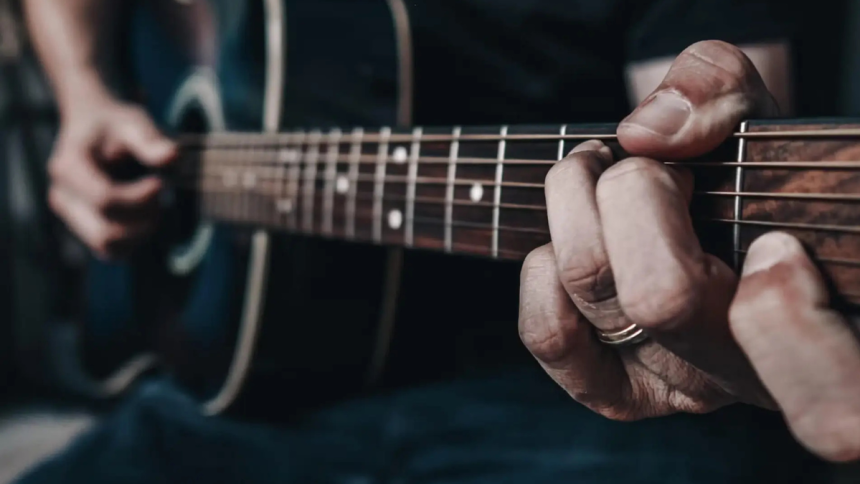There’s a point in every guitar player’s life when the whole thing just feels like a mistake. Your fingers are sore, your chord changes sound like a cat walking across a piano, and that beautiful riff you tried to nail? It came out more like an unintentional tribute to amateur hour. And while it’s easy to romanticize the early days—messing around, feeling inspired, convincing yourself you’re one good practice session away from greatness—reality eventually stomps in with its muddy boots and asks: are you really going to keep at this?
But let’s get one thing straight. Feeling stuck isn’t a sign that you’re bad at it. It’s a sign that you’re doing it right. That ache in your hands, that frustration with barre chords, the days where your progress flatlines—all of it’s proof that you’re building something. Most people hit that wall and walk away. If you don’t, you’re already in a different category.
That One String Won’t Kill You
Everyone has that one string. The one that buzzes no matter how carefully you press it down. The one that throws the whole chord off. The thing is, there’s no trick to getting past it besides doing it again and again. Which is what makes playing guitar such a unique kind of discipline. It doesn’t reward shortcuts. It asks for time, attention, and an ability to be okay with not being instantly good.
There’s a certain kind of peace that sneaks in when you finally stop obsessing over perfection and just play. Some days your hands cooperate. Some days they don’t. The trick is showing up either way. That slow crawl from sounding like a mess to something halfway decent is more satisfying than most people realize. And somewhere in that crawl, you’ll find rhythm, timing, tone, and something a little like confidence that doesn’t have to announce itself. It’s quieter than that. Stronger too.
When you finally get the hang of something that felt impossible a few weeks ago—whether it’s a clean F chord or your first halfway-decent attempt at a lead line—it doesn’t just feel like progress. It feels like ownership. And when you start weaving in other sounds, adding a bit of bass guitar or layering textures you couldn’t before, the whole thing expands. You’re not just playing anymore. You’re building a sound.
Progress Is Slower Than You Want But Faster Than You Think
Guitar playing doesn’t follow a neat timeline. There are no gold stars or checklists that tell you when you’re officially good. One day you’re faking your way through a song, and a month later, you’re playing it without thinking. But when you’re in it, it always feels like it’s taking forever.
That’s where a lot of people get thrown off. They look for a shortcut—some new gear, a different app, a YouTube video that promises faster results. And while that stuff can help in small ways, there’s no substitute for picking it up every day and making noise. The progress is there. You just won’t always notice it right away.
The trick is being okay with playing badly for a while. Maybe even longer than a while. If your goal is to play because you love it—and not because you’re performing for anyone else’s approval—then being bad at it stops being embarrassing. It becomes part of the deal.
Gear’s Not the Problem. But It Can Be the Motivation.
Let’s be real. The right guitar can change everything. Not because it makes you instantly better, but because it makes you want to play. There’s a reason people obsess over tonewoods, pickups, and neck shapes. It’s not just gear lust. It’s because when your guitar feels like yours, it gets harder to walk past it without picking it up.
This is especially true if you’ve struggled to find a guitar that fits your hands, your posture, or your playing style. There’s nothing wrong with needing something specific. Maybe the neck always felt too fat. Maybe your fingers don’t land quite right. That’s not a failure on your part. It just means you haven’t met your match yet.
That’s why left-handed guitars matter. If you’ve been trying to learn while constantly adapting to a setup that was never built for you, it’s not surprising things feel off. A properly designed lefty doesn’t just make playing easier. It makes sense. It clears away the unnecessary friction so you can actually focus on what you’re trying to do—not on compensating for someone else’s layout. If that’s been your holdup, it’s fixable. And worth fixing.
Playing Guitar Isn’t About Being Good. It’s About Being In It.
There’s a strange sort of therapy in letting your fingers fumble around a fretboard. You start to hear things differently. You start to feel things differently too. It doesn’t have to be pretty. Most of the time, it isn’t. It’s clumsy, inconsistent, off-key. But there’s something honest in that. Something you don’t get from a screen or a scroll.
It’s also one of the last places left where you can completely lose track of time and not feel bad about it. Nobody’s grading you. Nobody’s waiting for your progress report. It’s you, your guitar, and whatever came out of your hands at that moment. That kind of freedom is rare.
So maybe the next time you think about putting it away for a while, don’t. Leave it out where you’ll see it. Let your fingers land on it without thinking. Let it be part of your daily rhythm, even if it’s just for a few minutes. That’s how it sticks.
Keep Your Strings Close
You don’t need to be brilliant. You just need to keep going. Half of learning guitar is giving yourself the space to suck for a while. The other half is noticing that, somewhere in the middle of all that sucking, you’re getting better.
It’s not about the speed. It’s about the return. The way your hands start doing things they couldn’t do last month. The way a riff that used to intimidate you suddenly becomes doable. That’s the stuff that matters. That’s what stays.
If you’re in that phase where everything feels uphill and nothing sounds right, take a break if you need to—but don’t walk away. Leave the amp on. Keep the strings tuned. Stay with it. You’re already closer than you think.
Lynn Martelli is an editor at Readability. She received her MFA in Creative Writing from Antioch University and has worked as an editor for over 10 years. Lynn has edited a wide variety of books, including fiction, non-fiction, memoirs, and more. In her free time, Lynn enjoys reading, writing, and spending time with her family and friends.















